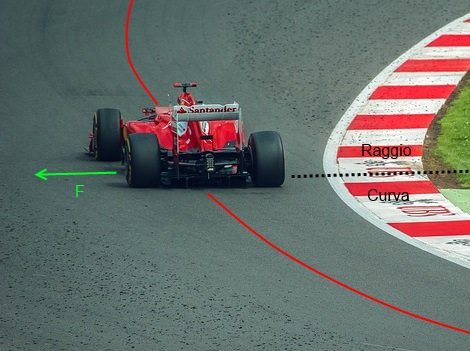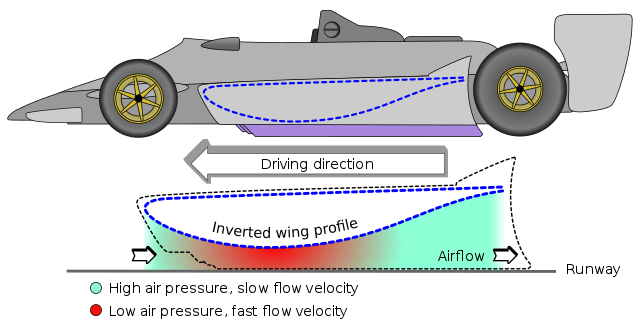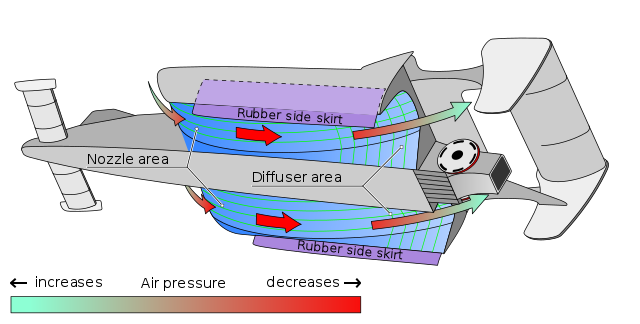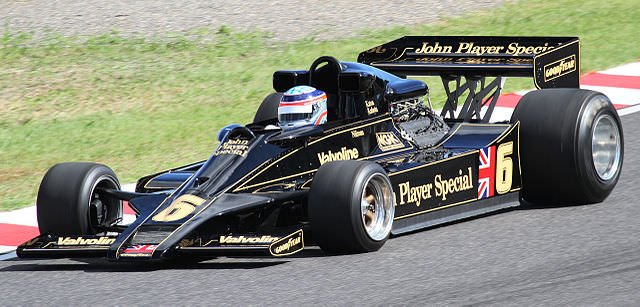SKIRTS …the importance of curves…

Here there is an English translation of a post by @knfitaly entitled MINIGONNE ...imPORTANZA delle CURVE and translated by the @davinci.polyglot team. The original post was not curated by steemstem by request of the author.
SKIRTS
…the importance of curves…

Nicola Fruet - knife artisan - Trentino - Italy
…that sometimes (lately it occurs often…) gets out from his basement.

COVER IMAGE CC by 3.0 - WIKIPEDIA Author Kirill Sogomonov
Admit it!! I tricked you! You probably believed that this post was about girls' skirts...instead...…
GROUND EFFECT
Over time, F1 cars increased their performances in terms of power and also can complete laps in less time, all while respecting strict FIA regulations.
Interestingly, the maximum speed of these cars did not increase significantly. Then the question is: how can F1 cars complete laps in less time while not increasing their maximum speed? Well, much the effort is focused on increasing the speed during curves. However, taking curves too fast can cause some issues.
Engineers know very well that increasing the speed in curves will also increase the centrifugal force, and if you want to keep the car on the circuit you have to counteract this force.

As we can see from the previous formula, this force is directly related to the mass (the weigh of the car) by the squared of the speed and inversely proportional to the radius of the curve. This means that if you were to keep the weight of the car and radius of curve constant but you were to try to increase the speed from 30Km/h to 60Km/h, you would face a centrifugal force four times higher.

Let's see how the idea of the the side skirts was conceived to increase the performance of F1 cars.
WE WERE ON THE WRONG PAGE! WE SHOULD LOOK INSTEAD AT THE CHAPTER ABOUT BERNOULLI !
In my imagination, this is a summary of the chat that occurred between Colin Chapman, Peter Wright and Tony Rudd [1] right after a test in the wind tunnel - Imperial College 1976. That year, Lotus performed some tests in the wind tunnel where they tried to apply some lateral extensions to their F1 car prototype.
The aim was that of creating a flipped wing to increase the DOWNFORCE of the car by harnessing the same laws of physics that allow a plane to fly.
Like the speed difference between the air beneath and above plane wings enable it to overcome gravity, at the same way if we flip the wing profile to an F1 car we will increase the downforce of the car, thus enabling it to take curves faster.

WING PROFILE, THE AIR ABOVE THE WING HAS HIGHER SPEED THAN AIR BENEATH, THIS PHYSICAL PHENOMENON CREATES A PRESSURE DIFFERENCE– Image CC0 Creative Commons WIKIPEDIA
The prototype that was tested at the wind tunnel, not only was equipped with a flipped wing but it also had two side appendices made of plywood that almost touched the ground (their edge was just 2.5 cm from the ground). However, after the signal “wind on”, after the air reached a certain speed, the plywood appendices collapsed! This was probably due to the material used, plywood, that was not adequate to withstand the mechanical stress, and they first bent inwards and then broke completely. Initially this test was seen as a failure, nonetheless this was the trigger for a much heighten focus on aerodynamics in F1 cars and this accident paved the way for the development of the side skirts we can see today in F1 cars.


The intuition that led to the adoption of a “closed” winged profile was something the revolutionized the design of F1 cars. Colin Chapman, Peter Wright and Tony Rudd did not fully expect what was about to happen, because the expected outcomes were based on the downforce calculations regarding only the wing profile, however, the new “closed” wing design and the ground beneath, formed a “tunnel” therefore we have now a closed conduit subject to Bernoulli’s law and the Venturi effect.
As we can see in the first image, the air that enters in the frontal portion of the car has a speed that (excluding the speed of the wind) should be equal to the speed of the car. However, if we narrow the section, the same amount of air to go through has to increase its speed. This occurs because of the Bernoulli’s law. In this narrow section we have a phenomenon of depression, the difference in speed between the two fluids (between the inner and outer portion of the conduit) generates downforce, pushing the car towards the ground. The first F1 car that adopted this system was the Lotus 78 that was equipped with these appendices on the side also known as side skirts

ISSUES OF SIDE SKIRTS
If from an aerodynamic point of view, the side skirts were something of a godsend, on the other hand, it generated some issues. The system itself was generating so much downforce that the first prototypes often collapsed during tests in the wind tunnel. Therefore, the first issue was to compensate for this with a more rigid framework. Even the suspensions had to become more rigid and less flexible affecting their ability to cushion shocks. All these changes affected the drivability of the F1 cars. Once the pilot set up to turn in a certain way, he could not change trajectory easily, it was a bit like if the car was fixed on some rails, the speeds that F1 cars could reach were impressive for those times. Obviously, the fact that the pilot was unable to change trajectory during turns was a big issue.
The reasons were simple, if for some reasons this tunnel (between the car and the ground) was not “sealed” anymore, the whole system would have lost completely its efficacy. There are several instances in which the pilot could make a mistake while taking a turn and he could touch the curb.. So if for some reasons the distance between the side skirts and the ground increases we would not have a sealed tunnel anymore, so the stability generated by the side skirts would be lost. The car would not have anymore the equilibrium between centrifugal force, downforce, the friction generated by the wheels..the car would literally fly. Even small objects on the road could destabilize the cars, and it occurs frequently that a car in front of you may lose some bits that could affect the efficacy of the side skirts.
Unfortunately, we had to learn this the hard way, there were some fatal accidents over the years. On August 1rst 1980, Patrick Depailler died during a test in the Hockenheim circuit (even if officially the causes were never fully understood). Among some of the most famous pilots, we have Gilles Villeneuve that during the qualifications laps for the Belgium GP in 1982 was driving a Ferrari 126 C2. Suddenly, just after a turn, Villeneuve found himself right behind a slower car and because he could not change his trajectory the impact between the two cars was unavoidable, the car of the canadian pilot literally took off...
After this tragedy, they changed the rules and in the year 1983, side skirts were banned. However, F1 never stops innovating and researching new technological advances, that’s why every year we continue to push our limits and beat new records.
REFERENCES
Post inspired by: L’effetto suolo in formula 1 from: link
[1]
Anthony Colin Bruce Chapman (Richmond, 19 May 1928 – Norwich, 16 December 1982) he was an engineer, a pilot and a british entrepreneur known for having founded the car company Lotus. Source Wikipedia
Anthony Cyril Rudd (8 March 1923 – 22 August 2003) was an engineer involved in aero engine design and motor racing, with particular associations with BRM and Lotus. Source Wikipedia
CENTRIFUGAL FORCE reference WIKIPEDIA
BERNOULLI EQUATION reference WIKIPEDIA
VENTURI EFFECT sources WIKIPEDIA
 Immagine CC0 Creative Commons, si ringrazia @mrazura per il logo ITASTEM. CLICK HERE AND VOTE FOR DAVINCI.WITNESS
Immagine CC0 Creative Commons, si ringrazia @mrazura per il logo ITASTEM. CLICK HERE AND VOTE FOR DAVINCI.WITNESS
I admit... You really had me there with the introduction.. Hahaha!
Then i realized its not all about the female skirt.
funny post ... scientific post
thank for your comment, nicola
Troppo forte ;-)))
Grazie mille
Congratulations! Your post has been selected as a daily Steemit truffle! It is listed on rank 3 of all contributions awarded today. You can find the TOP DAILY TRUFFLE PICKS HERE.
I upvoted your contribution because to my mind your post is at least 54 SBD worth and should receive 195 votes. It's now up to the lovely Steemit community to make this come true.
I am
TrufflePig, an Artificial Intelligence Bot that helps minnows and content curators using Machine Learning. If you are curious how I select content, you can find an explanation here!Have a nice day and sincerely yours,

TrufflePigContent type: long, popular
Awarded 4.5 out of 6 owls:





Details: There are a number of glaring spelling and grammatical errors so half a spelling and grammar owl was not awarded. The originality owl was not awarded since it requires the science to be explained in a novel/creative way.